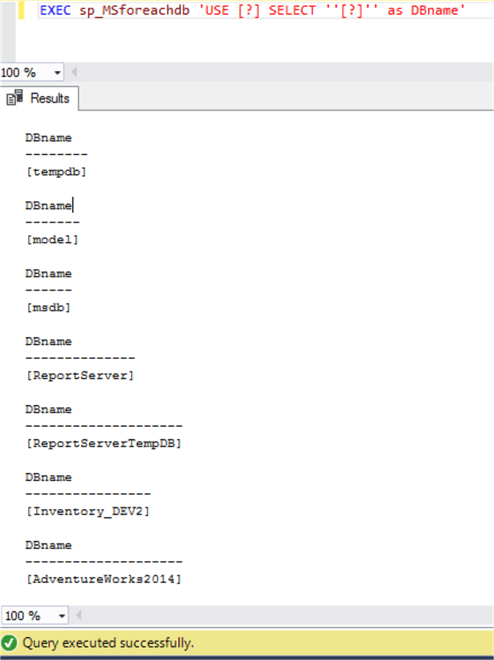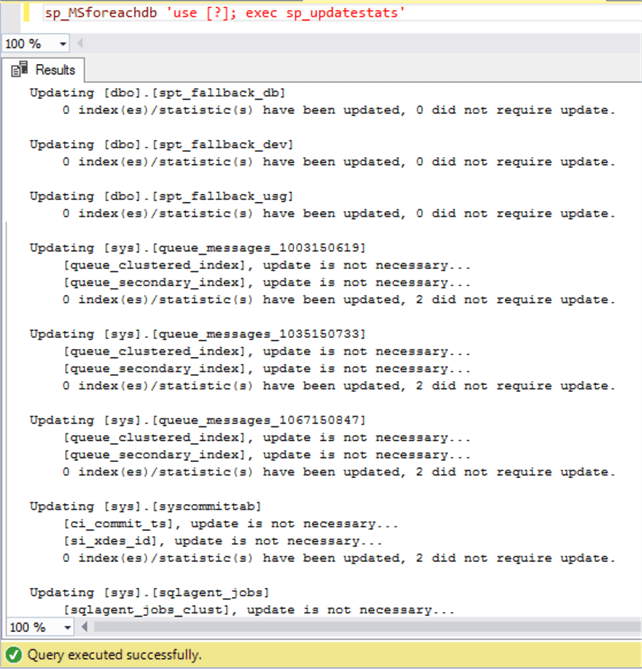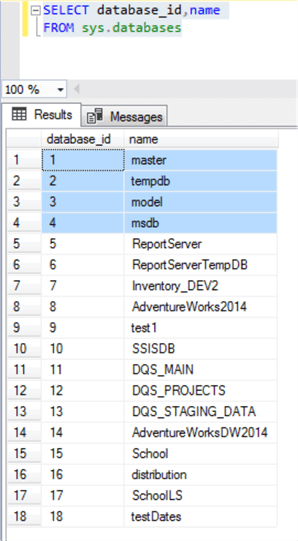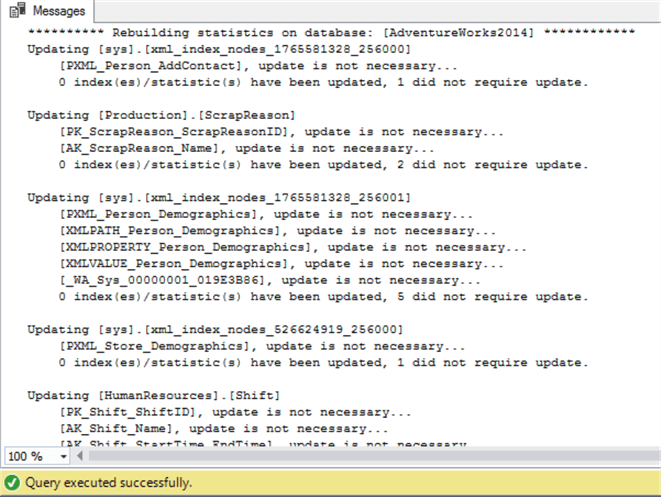By: Eduardo Pivaral | Comments (2) | Related: > Maintenance
Problem
You are a database administrator and have hundreds of SQL Server instances. One common administration task is to update statistics for your database objects for query optimization, if you have a lot of instances with large tables to work with this can be a time consuming task. Also, if you are handed new instances, you don’t know the status of the indexes and statistics, so you may want to update them for all tables on all databases with a single script, this is especially important when restoring databases or performing migrations to have up to date statistics to avoid performance issues.
Solution
With the help of the undocumented stored procedure sp_MSforeachdb we can achieve this task with a simple script to improve query performance. The sp_MSforeachdb stored procedure uses a global cursor to issue a Transact-SQL statement against each database on an instance.
Below is the basic usage. This will iterate over each database and display the database name. The "current" database is indicated by [?] which gets replaced dynamically with each database name including the system databases.
EXEC sp_MSforeachdb 'USE [?] SELECT ''[?]'' as DBname'
If we execute the query, we will have output like this:

Updating Statistics for a SQL Server Database
The second part of the solution is to create a Transact-SQL query to update all statistics for a given database. This is achieved with the use of procedure sp_updatestats. This runs the UPDATE STATISTICS command against all user defined tables in the current database.
The basic usage is:
sp_updatestats
Executing Update Statistics for all SQL Server Databases
Now if we combine these 2 procedures, we can create a script that will update statistics on all tables for all databases on a SQL Server instance.
The basic command will look like this:
sp_MSforeachdb 'use [?]; exec sp_updatestats'
If we execute it, the output will be something like this in SQL Server Management Studio:

The script was executed against all databases, including the system databases. But what If you want to exclude system databases from the script?
Excluding SQL Server System Databases from the Script
If you want to execute the above script and exclude system databases, some additional code must be put in place. We know that system databases are identified by database ID 1 to 4, as you can see with this simple select query:
SELECT database_id, name FROM sys.databases
If we execute it, we can see the database id’s belonging to the system databases in SQL Server Management Studio::

All we need to do is to modify our script to filter those database IDs from the execution. To have cleaner code, I separated the T-SQL for updating the statistics into a parameter, like this:
DECLARE @TSQL nvarchar(2000) -- Filtering system databases from execution SET @TSQL = ' IF DB_ID(''?'') > 4 BEGIN USE [?]; exec sp_updatestats END ' -- Executing TSQL for each database EXEC sp_MSforeachdb @TSQL
If you execute the query, this will only update databases that have a DB_ID > 4.
Excluding Specific User Databases from the sp_updatestats T-SQL Script
There can be some cases where you want to exclude specific databases from the update, and you can do it by adding just a few lines of code to the script.
We can filter the databases using an IN operator in the IF statement, as follows:
DECLARE @TSQL nvarchar(2000) -- Filtering system databases and user databases from execution SET @TSQL = ' IF (DB_ID(''?'') > 4 AND ''?'' NOT IN(''distribution'',''SSISDB'',''ReportServer'',''ReportServertempdb'') ) BEGIN PRINT ''********** Rebuilding statistics on database: [?] ************'' USE [?]; exec sp_updatestats END ' -- Executing TSQL for each database EXEC sp_MSforeachdb @TSQL
As you can see, we use a NOT IN operator to indicate what databases we want to exclude. For this example, we included some of the other system databases that are used for other SQL Server components. We have also included a print statement to show what database are being updated for each iteration.
This is a sample result of the query execution:

More about SQL Server sp_updatestats
According to Microsoft documentation, as we commented earlier, this function executes UPDATE STATISTICS against all user defined and internal tables on a database.
You can also specify the RESAMPLE parameter as well. This is used to update each statistic using its most recent sample rate. Allowed values for this parameter are NO and RESAMPLE, with NO as the default. Using RESAMPLE may cause full table scans for indexes, while using NO will use the most recent sample rate.
Usage of this parameter is:
EXEC sp_updatestats @resample = 'RESAMPLE'
The permissions required to execute sp_updatestats are sysadmin or being a database owner.
The method described above is best suited when you receive the server the first time, running the script frequently can be unnecessary and will only cause high resource consumption. Although you will notice that statistics will not be updated if not required, if you look at the image above you can see the where it says "did not require update".
Also, please have in mind that updating statistics can cause related queries to recompile.
With AUTO_UPDATE_STATISTICS enabled, statistics are updated automatically by the database engine when row count changes for a column reach a threshold, you can read more about this threshold in the official documentation by Microsoft.
Also Microsoft provides an Adaptive Index and statistics maintenance solution, that can be found here: https://github.com/Microsoft/tigertoolbox/tree/master/AdaptiveIndexDefrag.
Why is it important to update statistics?
Statistics are used by the Query Optimizer to create execution plans based on statistical distribution of required values, the information is stored in BLOBs (binary large objects). Value cardinality or a histogram is used to determine the number of rows to return, and execution plans are built with this information. Density is the number of duplicated values a column can have, this is used to calculate selectivity and enhance cardinality / histogram estimates. For unique values, the density is 1. High density variations on a given column can lead to parameter sniffing issues. Also, outdated or non-existent statistics can lead to poor performing queries or sub-optimal query plans.
Next Steps
- Check this tip for info about filtered statistics.
- Check this tip for info about DBCC SHOW_STATISTICS utility.
- Read more about statistics here Microsoft official documentation.
- Move SQL Server Maintenance Plan from One Server to Another
- SQL Server Maintenance Plan Index Rebuild and Reorganize Tasks
- Getting Started with SQL Server Maintenance Plans - Part 1
About the author
 Eduardo Pivaral is an MCSA, SQL Server Database Administrator and Developer with over 15 years experience working in large environments.
Eduardo Pivaral is an MCSA, SQL Server Database Administrator and Developer with over 15 years experience working in large environments. This author pledges the content of this article is based on professional experience and not AI generated.
View all my tips






